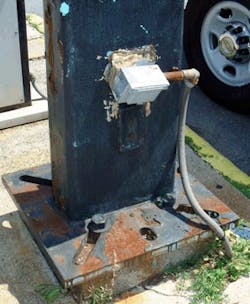Lack of Support
This receptacle box is located on the bottom portion of a sign support structure. Let’s start by pointing out the fact that there is no support for this piece of flexible metal conduit, the angle connector, or the short conduit nipple. It’s also pretty obvious the lack of support at the receptacle box allowed the box to pull away from the metal structure. Instead of properly supporting the box and conduit after the fact, someone thought it would be better to fill the gap with a bunch of clay or sealant. What a mess!
We can also point out the use of an improper receptacle cover at this location. As per 406.9(B)(1), “15A and 20A, 125V and 250V receptacles installed in a wet location shall have an enclosure that is weatherproof whether or not the attachment plug cap is inserted.” This receptacle would also have to be protected by a GFCI in accordance with 210.8(B)(4). In addition, as noted in 406.4(A)(6), “weather-resistant receptacles shall be provided where replacements are made at receptacle outlets that are required to be so protected elsewhere in this Code.”
In or Out?
Located in a narrow alley in the financial district of a big city, this image shows a modification of the original installation. This alley is used for trash and delivery trucks, which most likely caused this physical damage. These exposed energized conductors present a dangerous situation that must be fixed.
As defined in Art. 100 of the NEC, a conduit body is “A separate portion of a conduit or tubing system that provides access through a removable cover(s) to the interior of the system at a junction of two or more sections of the system or at a terminal point of the system.”
This situation does not comply with the requirements of 314.15, which states: “In damp or wet locations, boxes, conduit bodies, and fittings shall be placed or equipped so as to prevent moisture from entering or accumulating within the box, conduit body, or fitting. Boxes, conduit bodies, and fittings installed in wet locations shall be listed for use in wet locations.”
About the Author
Joe Tedesco
Tedesco served the industry in many roles during his career. He was a director, senior electrical code instructor for National Technology Transfer, Inc. and American Trainco, Inc.. He was also a codes, standards and seminar specialist for the International Association of Electrical Inspectors and an electrical field service specialist for the National Fire Protection Association in Quincy, Mass. He ran his own business as an NEC consultant and is a Massachusetts licensed master electrician and journeyman electrician and certified electrical inspector (one and two family 2A; General 2B, and Plan Review, 2C). Tedesco also wrote articles for CEE News and EC&M (Code Violations Illustrated and What's Wrong Here?) for more than 15 years and helped launched the Moving Violations video series.
